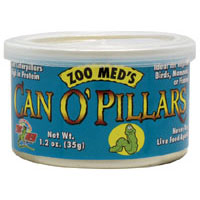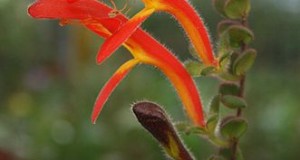The Green or Carolina Anole, Anolis carolinensis, has introduced generations of herp enthusiasts to reptile-keeping. Small, active, and willing to breed in captivity, this handsome arboreal lizard makes a wonderful pet. Although associated with “beginners”, Green Anoles are complex creatures, well able to hold the interest of lifelong herpetologists and pet keepers, myself included. A huge array of relatives (there are over 370 anole species!), many available in the pet trade, can be kept in a similar manner. Today I’ll review supplies for Anoles and similar lizards to get you started off right. Please see the linked articles, and post questions below, for detailed information on care and breeding.
The Terrarium
Although small, Green Anoles active and require spacious terrariums; they become stressed in tight quarters. A single animal can be housed in a 15 gallon tank; pair or trio should be provided with a 20 gallon aquarium.
The Zoo Med Repti-Breeze Aluminum/Screen Cage is perhaps the best option. It provides critical air circulation and, when placed outdoors, also allows for UVB exposure (glass and plastic filter-out UVB rays).
The extra-tall Exo Terra Terrarium can also be fashioned into an excellent anole habitat.
Terrarium Furnishings
Numerous branches should be provided, along with plants and vines. Anoles will be stressed in a bare terrarium – plants provide “sight barriers” that offer security and ease aggression among tank-mates.
A wide variety of artificial plants specifically designed for use in reptile terrariums can be put to good use by anole owners. I favor hanging plants with suction cups…when attached to glass, they greatly increase the cage’s usable surface area. Cork tile backgrounds serve a similar function.
Live plants will help you to create a stunning exhibit. Snake Plants, Pothos, Philodendron, Peace Lilies and other sturdy house plants will be well-used by these little gymnasts.
Basking sites should be plentiful, as dominant individuals will exclude others from these important areas. Driftwood, Java Wood, vines and tree branches will all be used by anoles and other lizards.
Substrate
The substrate should be capable of holding moisture. Cypress mulch, coconut fiber and commercial rainforest substrates are all suitable. In especially dry environments, sphagnum moss can be added to improve water-retention.
Light
Green Anoles will not thrive if denied access to UVB radiation. If a florescent bulb is used (the Zoo Med 10.0 UVB Bulb is ideal), be sure that all animals can bask within 6-12 inches of it. Mercury vapor and halogen bulbs broadcast UVB over greater distances, and provide beneficial UVA radiation as well.
Heat
The ambient, or average, air temperature should range from 80-87 F, with a basking spot of 92-95 F. Incandescent bulbs should be used to maintain these temperatures. Temperatures can dip to the low 70’s after dark. A ceramic heater or red/black reptile “night bulb” can be used if night-time heating is required.
Humidity
Green Anoles do best when provided with moderately high humidity levels, but they also require air circulation and dry areas. The terrarium should be misted at least twice daily. A screen top, or the screen cages mentioned above, will ensure adequate ventilation.
Small reptile humidifiers and misters can be put to good use in dry homes.
Food
Be prepared to offer your anoles (and all insectivorous lizards) a wide variety of food items. Crickets alone, even if powdered with vitamins, are not sufficient.
 Other critical foods include small roaches, calciworms, butterworms, silkworms, lab-reared houseflies, and field collected invertebrates such as moths, hairless caterpillars, small beetles and harvestmen (“daddy longlegs”). The Zoo Med Bug Napper is a valuable insect-collecting tool.
Other critical foods include small roaches, calciworms, butterworms, silkworms, lab-reared houseflies, and field collected invertebrates such as moths, hairless caterpillars, small beetles and harvestmen (“daddy longlegs”). The Zoo Med Bug Napper is a valuable insect-collecting tool.
In order to increase dietary variety, try offering canned silkworms via feeding tongs.
A mixture of papaya/apricot baby food, honey, a liquid reptile vitamin supplement and water should be offered weekly.
Food offered to adult anoles should be sprinkled with a vitamin/mineral supplement 2-5 times per week, depending upon dietary variety (please post below for detailed information). Young animals require supplementation with most meals. I favor ReptiVite and ReptiCal.
Anoles generally refuse to drink water from bowls; their enclosure should be misted twice daily, whereupon upon they will lap up the droplets.
 That Reptile Blog – Reptile, Amphibian and Exotic Pet Care and Information
That Reptile Blog – Reptile, Amphibian and Exotic Pet Care and Information





I see green anoles all the time around the Tampa, FL area. Is it primarily the skin pigmentation that separates them from brown anoles? I guess what I am getting at, is it usually just the enhanced green color that gains interest with this species.
Hi Chris,
Yes, color is useful to distinguish them, as brown Anoles, Anolis sagrei cannot change color to green; also, brown anoles have a white longitudinal stripe on the throat, and along the border of the throat fan; neither present in green. Best, Frank
Hi! Thank you for all of your helpful advice! I just had one quick question. I am aware that anoles can crawl on walls with their sticky feet to drink water, but will they ever crawl on the top of their habitats? Because I’m thinking of getting one and I have a habitat to house him in already but there is a feeding hole in the top and I don’t know if he will escape. It is a 10 gallon tank and it is quite tall. Can they stick upside down on the top of their habitats or crawl up to the top?
Hi Mareena,
My pleasure. They cannot run upside down across ceilings as can some geckos, but their feet can make use of any irregularities on the glass or plastic cage sides, and it could leap from there to the hole perhaps; they can hang upside down on screening. In my experience, if there’s a way out, they will find it. Can you use aquarium silicone to seal the hole with screening?
Best, Frank
Frank , I have kept many anole species and have had baby Allisoni and Sabanus anoles . The longest I have kept 2 Allisoni babies alive is one month . I have lost three Sabanus in less than three days and have one left . I had them in a 15 gallon terrarium . Fed them fruit flies . Added bean beetles and pin heads .Why do they die off ? The temps are 80 ‘s day upper 70’s night . It is weird that the three sabanus died within one week that I added pinhead crickets .
Any suggestions /
Thanks , Monk
Hi Scott,
Difficult to say…I always provide lots of wild caught “filed plankton”, leaf litter invertebrates etc,, but nutritional probs would not likely cause deaths so quickly. In other species, nutritional deficiencies that do not seem to hinder adults can cause poor survival rates in youngsters. hatchlings are sometimes wary of basking, which could lead to CA probs, but again not so quickly. Please feel free to send info re adult diets, and let me know if you need articles on collecting/trapping inverts. Best, Frank
Hi Frank,
I am interested in adding live plants to my Cuban Knight Anole’s terrarium. Do you have any general advice on how to go about this? Are there any common mistakes to avoid, and what are the pros and cons? Thanks!
Ray
Hi Ray,
Great idea, they do much better with lots of cover in form of live plants. No concerns re absorbing pesticides, but rinse leaves well as lizard will be lapping water from leaves. Uvb bulbs used for herps are fine for typical terrarium plants. Sturdy species such as philodendron, snake plants, peace lilly (info here) are best, as they offer cover and will support weight. Pothos is great – grows as a vine, can be trampled, etc. For ground cover etc, tough-leaved varieties such as cast iron plant, Chinese evergreen, earth stars very good. Please let me know if you need more info, enjoy, frank
What vegetable plants can i plant in my green anole home?